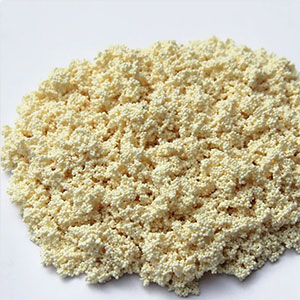



| Item | Index | |
|---|---|---|
| Appearance | Colorless, odorless, tasteless and lustrous transparent solid. | |
| Purity %≥ | 98 | |
| Resins | Polymer Matrix Structure | Physical Form Appearance | FunctionGroup | Ionic Form | Total Exchange Capacity meq/ml | Moisture Content | Particle Size mm | Shipping Weight g/L |
| DL401 | Macroporous Ploy-styrene with DVB | Opaque Spherical Beads | Iminodiacetic Acid | Na | 0.8 | 55-65% | 0.425-1.2 | 750 |
| DL402 | Macroporous Ploy-styrene with DVB | White Spherical Beads | Aminophosphonic | Na | 0.9 | 55-66% | 0.425-1.2 | 750 |
| DL403 | Macroporous Ploy-styrene with DVB | Opaque Spherical Beads | Methylglucamine | Free Base | 0.9 | 50-60% | 0.425-1.2 | 750 |
| DL405 | Macroporous Ploy-styrene with DVB | Opaque Spherical Beads | Thioureido | H | 0.8 | 45-50% | 0.425-1.2 | 750 |
| DL406 | Macroporous Ploy-styrene with DVB | Grey Opaque Spherical Beads | — | AI | 0.5 | 50-55% | 0.30-1.20 | 750 |
| DL407 | Macroporous Ploy-styrene with DVB | White Spherical Beads | R-N(CH3)2(C2H2OH)- | CI | 0.9 | 50-56% | 0.30-1.20 | 700 |
| DL408 | Macroporous Ploy-styrene with DVB | Brick Red to Brown Spherical Beads | FeO(OH) | — | 0.6 | 50-56% | 0.30-1.20 | 700 |
| DL410 | Macroporous Ploy-styrene with DVB | Opaque Spherical Beads | Quaternary Ammonium | CI | 0.75 | 40-50% | 0.30-1.20 | 700 |
| Packing | in 25kg bags |
|---|---|
| Storage | 20°C,2 years |
| Shipping | Room temperature in China;may vary elsewhere |
Tel: 0086 25 52397805
Email: info@nj-finechem.com

| Common Names | Wang resin | ||
|---|---|---|---|
| Structure | 
|
||
| CAS No. | 201058-08-4 | Boiling Point (℃) | 386.2ºC at 760 mmHg |
| Molecular Weight | 228.286 | Melting Point (℃) | N/A |
| Appearance | Off-white to beige beads | Vapor Specific Gravity | — |
| HS Code | 3909400000 | Flash Point (℃) | 175.2ºC |
| Solubility | — | Autoignition Temperature (℃) | — |
| Safety Phrases | 26-36/37/39-24/25 | ||
|---|---|---|---|
| RIDADR | 2211 | ||
| WGK Germany | 3 | ||
| Packaging Group | III | ||
| Hazard Class | — | ||
| SYMPTOMS | PREVENTION | FIRST AID | |
| Inhalation | poisonous | wear a mask | fresh air,keep breath comfortable |
| Skin | skin burn | wear protective clothing | Remove all soiled clothing and wash your skin with water. |
| Eyes | eye injury | wear goggles | Rinse slowly and gently with water for a few minutes |
| Ingestion | poisonous | Do not eat, drink or smoke while using this product | Call a POISON CENTRE or doctor |
